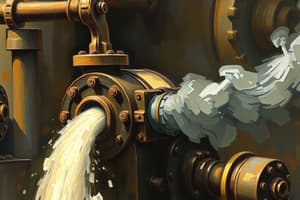Podcast
Questions and Answers
Both cross flow and counter flow designs can be used in natural draft cooling towers.
Both cross flow and counter flow designs can be used in natural draft cooling towers.
True
The concentration of chlorides in circulating water (C) can be represented by XC.
The concentration of chlorides in circulating water (C) can be represented by XC.
True
Fog is always present in cooling towers.
Fog is always present in cooling towers.
False
A typical coal-fired power plant producing 700 MW needs 315,000 U.S. gallons per minute of cooling water.
A typical coal-fired power plant producing 700 MW needs 315,000 U.S. gallons per minute of cooling water.
Signup and view all the answers
Net Positive Suction Head (NPSH) is a factor affecting the efficiency of a cooling tower.
Net Positive Suction Head (NPSH) is a factor affecting the efficiency of a cooling tower.
Signup and view all the answers
Cooling towers are not affected by ambient conditions.
Cooling towers are not affected by ambient conditions.
Signup and view all the answers
Make-up water in a wet cooling tower can be represented as M.
Make-up water in a wet cooling tower can be represented as M.
Signup and view all the answers
Windage loss of water has no impact on the cycles of concentration in a cooling tower.
Windage loss of water has no impact on the cycles of concentration in a cooling tower.
Signup and view all the answers
Plumes of water vapor rising from a cooling tower indicate inefficient operation.
Plumes of water vapor rising from a cooling tower indicate inefficient operation.
Signup and view all the answers
The concentration of chlorides in make-up water (M) can be represented by XM.
The concentration of chlorides in make-up water (M) can be represented by XM.
Signup and view all the answers
Study Notes
NPSH (Net Positive Suction Head)
- NPSH available must be greater than NPSH required to avoid pump cavitation
- NPSH = Hp - Hvap + Hst - Hsf
- Factors affecting NPSH: temperature, viscosity, suction pressure, and supply restrictions
- Solutions to cavitation: reduce Hp or RPM, increase diameter of suction line
Cavitation
- Occurs when suction pressure falls below NPSH
- Liquid vaporizes, creating gas pockets that slug against components
- Seriously harms internal components
Positive Displacement Pumps (PDP)
- Use pistons, diaphragms, screws, vanes, and gears to displace liquid
- Trap a fixed volume of water and then displace it out
- Mechanical method can be either rotary or reciprocating
Rotary Pumps
- Most common type of PDP
- Use various rotary methods to convey liquid: screws, gears, vanes, lobes
Screw Pumps
- Use a screw to draw fluids through the shaft and into the discharge
- Create very little turbulence in the process
- Used to draw heavy and viscous fluids
Gear Pumps
- Use two mating gears inside a pump casing
- Three categories: centrifugal, positive displacement, and jet pumps
Centrifugal Pumps
- Centrifugal force of inertia propels liquids in a circular rotation into a discharge chute (volute)
- Advantages: relatively affordable, use less space, require less maintenance
- Come in a variety of shapes and sizes by design and for different applications
Centrifugal Pump Designs
- Horizontal and vertical (depending on shaft position)
- Single and multiple stage (referring to the number of impellers)
- Single and multiple suction inlets
- Axial, radial, and mixed flow
- Impeller design
Impellers
- Attached to shaft or on a plate attached to shaft
- Liquid enters eye, and impeller forces liquid out
- Three design types: open, closed, and semi-open
Head Pressure
- Pressure required to push fluid into impeller
- Also referred to as suction head
- Net Positive Suction Head (NPSH) is the minimum absolute pressure at the suction nozzle at which the pump can operate
Cooling Towers
- Material balance: M = Make-up water, C = Circulating water, D = Draw-off water, E = Evaporated water, W = Windage loss of water, X = Concentration in ppmw
- Cycles of concentration: XC / XM (dimensionless)
- Fog forms when conditions are right, and plumes of water vapor can be seen rising from a cooling tower
Studying That Suits You
Use AI to generate personalized quizzes and flashcards to suit your learning preferences.
Description
This quiz covers the concept of Net Positive Suction Head (NPSH) and how it relates to pump cavitation. It includes the formula to calculate NPSH available and the factors that contribute to NPSH required. Test your knowledge on preventing pump cavitation with this quiz!



